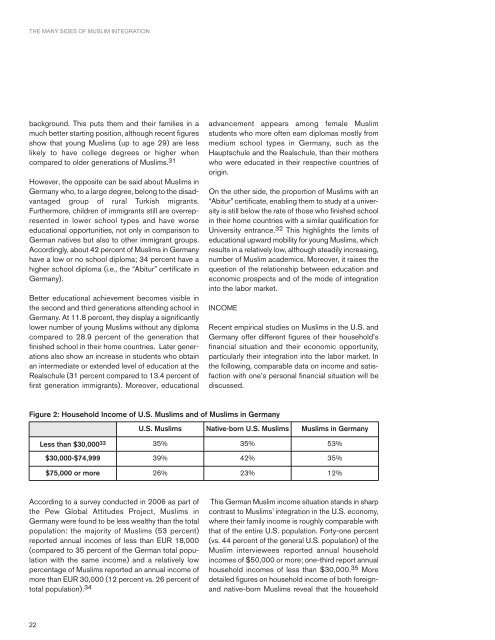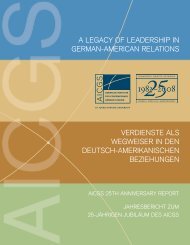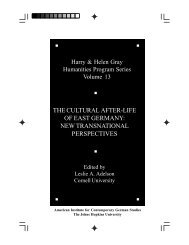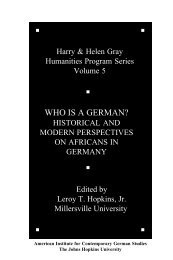the many sides of muslim integration: a german- american - aicgs
the many sides of muslim integration: a german- american - aicgs
the many sides of muslim integration: a german- american - aicgs
You also want an ePaper? Increase the reach of your titles
YUMPU automatically turns print PDFs into web optimized ePapers that Google loves.
<strong>the</strong> <strong>many</strong> <strong>sides</strong> <strong>of</strong> <strong>muslim</strong> <strong>integration</strong><br />
background. This puts <strong>the</strong>m and <strong>the</strong>ir families in a<br />
much better starting position, although recent figures<br />
show that young Muslims (up to age 29) are less<br />
likely to have college degrees or higher when<br />
compared to older generations <strong>of</strong> Muslims. 31<br />
However, <strong>the</strong> opposite can be said about Muslims in<br />
Ger<strong>many</strong> who, to a large degree, belong to <strong>the</strong> disadvantaged<br />
group <strong>of</strong> rural Turkish migrants.<br />
Fur<strong>the</strong>rmore, children <strong>of</strong> immigrants still are overrepresented<br />
in lower school types and have worse<br />
educational opportunities, not only in comparison to<br />
German natives but also to o<strong>the</strong>r immigrant groups.<br />
Accordingly, about 42 percent <strong>of</strong> Muslims in Ger<strong>many</strong><br />
have a low or no school diploma; 34 percent have a<br />
higher school diploma (i.e., <strong>the</strong> “Abitur” certificate in<br />
Ger<strong>many</strong>).<br />
Better educational achievement becomes visible in<br />
<strong>the</strong> second and third generations attending school in<br />
Ger<strong>many</strong>. At 11.8 percent, <strong>the</strong>y display a significantly<br />
lower number <strong>of</strong> young Muslims without any diploma<br />
compared to 28.9 percent <strong>of</strong> <strong>the</strong> generation that<br />
finished school in <strong>the</strong>ir home countries. Later generations<br />
also show an increase in students who obtain<br />
an intermediate or extended level <strong>of</strong> education at <strong>the</strong><br />
Realschule (31 percent compared to 13.4 percent <strong>of</strong><br />
first generation immigrants). Moreover, educational<br />
22<br />
advancement appears among female Muslim<br />
students who more <strong>of</strong>ten earn diplomas mostly from<br />
medium school types in Ger<strong>many</strong>, such as <strong>the</strong><br />
Hauptschule and <strong>the</strong> Realschule, than <strong>the</strong>ir mo<strong>the</strong>rs<br />
who were educated in <strong>the</strong>ir respective countries <strong>of</strong><br />
origin.<br />
On <strong>the</strong> o<strong>the</strong>r side, <strong>the</strong> proportion <strong>of</strong> Muslims with an<br />
“Abitur” certificate, enabling <strong>the</strong>m to study at a university<br />
is still below <strong>the</strong> rate <strong>of</strong> those who finished school<br />
in <strong>the</strong>ir home countries with a similar qualification for<br />
University entrance. 32 This highlights <strong>the</strong> limits <strong>of</strong><br />
educational upward mobility for young Muslims, which<br />
results in a relatively low, although steadily increasing,<br />
number <strong>of</strong> Muslim academics. Moreover, it raises <strong>the</strong><br />
question <strong>of</strong> <strong>the</strong> relationship between education and<br />
economic prospects and <strong>of</strong> <strong>the</strong> mode <strong>of</strong> <strong>integration</strong><br />
into <strong>the</strong> labor market.<br />
INCOME<br />
Figure 2: Household Income <strong>of</strong> U.S. Muslims and <strong>of</strong> Muslims in Ger<strong>many</strong><br />
Recent empirical studies on Muslims in <strong>the</strong> U.S. and<br />
Ger<strong>many</strong> <strong>of</strong>fer different figures <strong>of</strong> <strong>the</strong>ir household’s<br />
financial situation and <strong>the</strong>ir economic opportunity,<br />
particularly <strong>the</strong>ir <strong>integration</strong> into <strong>the</strong> labor market. In<br />
<strong>the</strong> following, comparable data on income and satisfaction<br />
with one’s personal financial situation will be<br />
discussed.<br />
U.S. Muslims Native-born U.S. Muslims Muslims in Ger<strong>many</strong><br />
Less than $30,000 33 35% 35% 53%<br />
$30,000-$74,999 39% 42% 35%<br />
$75,000 or more 26% 23% 12%<br />
According to a survey conducted in 2006 as part <strong>of</strong><br />
<strong>the</strong> Pew Global Attitudes Project, Muslims in<br />
Ger<strong>many</strong> were found to be less wealthy than <strong>the</strong> total<br />
population: <strong>the</strong> majority <strong>of</strong> Muslims (53 percent)<br />
reported annual incomes <strong>of</strong> less than EUR 18,000<br />
(compared to 35 percent <strong>of</strong> <strong>the</strong> German total population<br />
with <strong>the</strong> same income) and a relatively low<br />
percentage <strong>of</strong> Muslims reported an annual income <strong>of</strong><br />
more than EUR 30,000 (12 percent vs. 26 percent <strong>of</strong><br />
total population). 34<br />
This German Muslim income situation stands in sharp<br />
contrast to Muslims’ <strong>integration</strong> in <strong>the</strong> U.S. economy,<br />
where <strong>the</strong>ir family income is roughly comparable with<br />
that <strong>of</strong> <strong>the</strong> entire U.S. population. Forty-one percent<br />
(vs. 44 percent <strong>of</strong> <strong>the</strong> general U.S. population) <strong>of</strong> <strong>the</strong><br />
Muslim interviewees reported annual household<br />
incomes <strong>of</strong> $50,000 or more; one-third report annual<br />
household incomes <strong>of</strong> less than $30,000. 35 More<br />
detailed figures on household income <strong>of</strong> both foreignand<br />
native-born Muslims reveal that <strong>the</strong> household





